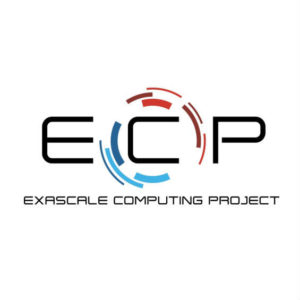 Researchers and staff from 15 National Labs will showcase DOE’s latest computing and networking innovations and accomplishments at SC18 in Dallas next week.
Researchers and staff from 15 National Labs will showcase DOE’s latest computing and networking innovations and accomplishments at SC18 in Dallas next week.
Experts from the 15 national laboratories will be sharing DOE booth #2433 featuring speakers, presentations, demonstrations, discussions, and simulations. Computational scientists working for DOE laboratories have been involved in the conference since organizing the first meeting in 1988 and this year’s event is no different. In fact, to mark the 30th anniversary of the initial conference, the DOE booth will feature a timeline showing seven decades of supercomputing breakthroughs at the national labs. Accompanying the timeline will be a display of artifacts from groundbreaking computers through the years, ranging from a 1950s vacuum tube-powered machine called MANIAC to a processor from Summit, currently the world’s fastest supercomputer.
 Several of the talks and demos will highlight achievements by DOE’s Exascale Computing Program (ECP), a multi-lab, seven-year collaborative effort focused on accelerating the delivery of a capable exascale computing ecosystem by 2021. The goal of the ECP is to enable breakthrough solutions that can address our most critical challenges in scientific discovery, energy assurance, economic competitiveness and national security.
Several of the talks and demos will highlight achievements by DOE’s Exascale Computing Program (ECP), a multi-lab, seven-year collaborative effort focused on accelerating the delivery of a capable exascale computing ecosystem by 2021. The goal of the ECP is to enable breakthrough solutions that can address our most critical challenges in scientific discovery, energy assurance, economic competitiveness and national security.
The booth will also feature work supported by the DOE Office of Science’s high performance computing centers: the Argonne and Oak Ridge Leadership Computing Facilities and the National Energy Research Scientific Computing Center (NERSC), all Office of Science national user facilities; and National Nuclear Security Administration computing centers at Lawrence Livermore, Los Alamos and Sandia national laboratories. Tying it all together will be DOE’s Energy Sciences Network (ESnet), an Office of Science national user facility which connects 40 DOE sites to their users and collaborators around the world through dedicated high-speed connections.
See the full schedule of events.
This year’s featured presentations are:
- Pete Beckman, Argonne National Laboratory, on “The Tortoise and the Hare: Is There Still Time for HPC to Catch Up to the Cloud in the Performance Race?”
- Panagiotis Spentzouris, Fermi National Accelerator Laboratory, on “Fermilab’s Quantum Computing Program”
- Sriram Krishnamoorthy, Pacific Northwest National Laboratory, on “Intense National Focus on QIS”
- Nick Wright, Lawrence Berkeley National Laboratory, on “Introducing NERSC-9, Berkeley Lab’s Next-Generation Pre-Exascale Supercomputer”
- Inder Monga, Lawrence Berkeley National Laboratory, on “ESnet6: Design of the Next-Generation Science Network”
- David Daniel, Los Alamos National Laboratory, on “The Ristra Project: Preparing for Multi-Physics Simulation at Exascale”
- Fred Streitz, Lawrence Livermore National Laboratory, on “Machine Learning and Predictive Simulation: HPC and the U.S. Cancer Moonshot on Sierra”
- Alexei Klimentov, Brookhaven National Laboratory, and Jack Wells, Oak Ridge National Laboratory, on “BigPanDA project: Workflow and Workload Management System for High Energy and Nuclear Physics, and for Extreme Scale Scientific Applications”
- Kerstin Kleese van Dam, Brookhaven National Laboratory, on “Real Time Performance Analysis of Applications and Workflows”
- Arthur “Buddy” Bland, Oak Ridge National Laboratory, on “An Overview of ORNL’s Summit Supercomputer”
- Mike Sprague, National Renewable Energy Laboratory, on “ExaWind: Towards Predictive Wind Farm Simulations on Exascale Platforms”
- Yee Ting Li, SLAC National Accelerator Laboratory, on “Hyperscale (Petabyte, Exabyte and Beyond) Data Distribution for Delivery of LCLS-II Free Electron Laser Data to Supercomputers”
- Doug Kothe, Oak Ridge National Laboratory, on “Exascale Computing Project Update”
- Jim Laros, Sandia National Laboratories, on “Vanguard-Astra: NNSA Advanced Architecture Prototype Platform”
- Jim Brandt, Sandia National Laboratories, on “Platform Independent Run Time HPC Monitoring, Analysis, and Feedback at Any-Scale”
- Graham Heyes, Thomas Jefferson National Accelerator Facility, on “Streaming Data for Nuclear Physics Experiments.”
The DOE Office of Science will be represented by Ames, Argonne, Brookhaven, Lawrence Berkeley, Oak Ridge and Pacific Northwest national laboratories, Fermi National Accelerator Laboratory, and Thomas Jefferson National Accelerator Facility. The National Nuclear Security Administration will be represented by Lawrence Livermore, Los Alamos and Sandia national laboratories. The Office of Energy Efficiency and Renewable Energy will be represented by the National Renewable Energy Laboratory; the Office of Environmental Management by Savannah River National Laboratory and the Office of Nuclear Energy by Idaho National Laboratory.



